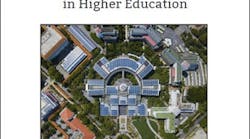The Genius of Microgrids in Higher Education
The U.S. higher education system ranks as the strongest in the world, besting all other countries because of its breadth of exceptional institutions and its reach to such a large percentage of the nation’s youth. Still, it faces some significant headwinds, not the least of which is the increased demand for new infrastructure in the face of leveling enrollment, heightened pressure to reduce costs and the COVID-19 pandemic.
At the same time, U.S. colleges and universities have taken the lead in fighting climate change, and setting ambitious sustainability and renewable energy goals. Now, add a new challenge: the need for reliable and resilient energy.
This paper explains how microgrids in higher education can help flip these problems into opportunities to prepare the workforce for the emerging new energy economy, while yielding low cost, reliable and clean sources of energy.
This paper is divided into three sections. The first chapter focuses on the energy challenges faced by higher education. The middle chapters explain how microgrids serve as a solution. The final chapter describes microgrids in action, serving not only as an energy solution but also as an educational tool. This paper focused on microgrids in higher education is being offered for download free of charge, courtesy of Siemens. We encourage you to share the link widely, particularly among decision-makers in higher education who are seeking more reliable, cleaner and cost-effective energy solutions.
